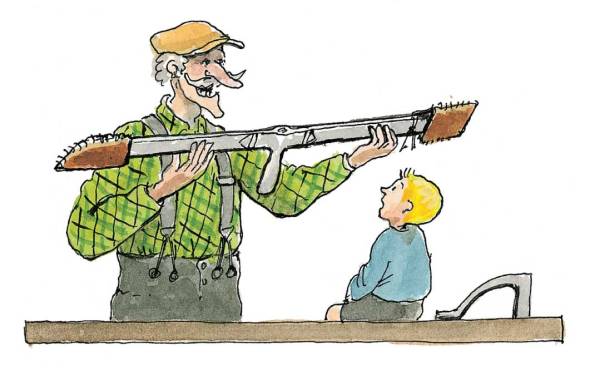In furniture-making circles, it is the highest compliment to say that another person has “wood in their blood.”
At Lost Art Press, we think that every individual has a deep connection to this incredible natural material. After all, the history of our civilization is so closely intertwined with that of the forest that it is almost impossible to discuss one without the other.
This connection, which is buried in both our genes and social history, needs only a spark of something to bring it alive into a flaming passion for wood – and building things with it.
And that is why we are particularly proud to announce the publication of “Grandpa’s Workshop” by Maurice Pommier, the latest title from Lost Art Press and our first children’s book.
This 48-page book was translated this year for us by Brian Anderson, an American-born writer and woodworker who lives and works in France. It is ostensibly a book for children, though the stories, lessons and drawing style will appeal to anyone who has an appreciation for the natural and the fantastical.
Pommier paints an unbroken line of craftsmen from a French family, and he traces the history of their lives and their work through their tools and the stories of them being handed from one worker to the other – against the backdrop of colonization, the gold rush, World War I and the time when Dragomir the dragon wreaked havoc in the Black Forest.
The tale is told through the eyes of Sylvain, the youngest of the woodworkers in the family, as he spends his vacation in the shop of his grandfather, who he calls Pépère. Sylvain wants to learn all about the hand tools in Pépère’s shop and the elves who hide amongst the shavings, benches and tool chests there.
As each tool’s story is told, Sylvain learns a little more about his family and its connection to woodworkers all over the world, and this eventually leads to him being haunted by a sad family secret that is told to him by the woodshop’s elves (in a dream).
“Grandpa’s Workshop” is a simply magnificent tale filled with hundreds of beautiful illustrations that you and your children will find intoxicating. It is a story that is untouched by the modern tendency to sugar coat stories for our children, and it is a little bit scary in parts – there is a vicious dragon, a tragic jobsite accident, a war and even a family murder.
In the end, of course, “Grandpa’s Workshop” is a tale that will fascinate and perhaps spark something in the reader – perhaps a love for wood, the mysteries of the forest or even working with one’s hands.
The English translation of this 2007 book has been approved by Pommier, the author. And we took pains to build the English version of this book so it matches the experience of reading it in the original French. We’ve even printed the book in an oversized European size with a special thick paper stock to closely match the original’s print run.
Like all Lost Art Press books, “Grandpa’s Workshop” is printed in the United States. Its signatures are Smythe sewn and casebound for durability. The price is $22.
This book is part of a special run of 3,000 copies that is authorized by the French publisher. We are not sure if the French publisher will authorize a second printing, so act now to avoid disappointment. Sounds like Ronco talk, but it’s not.
“Grandpa’s Workshop” is scheduled to ship from the printer the first week of October 2012. If you order it before that date, American customers receive free domestic shipping. You can order it now through our store here.
If you’d like to download a short excerpt in pdf format, click here.
We will announce the book’s availability through our other usual distributors as they sign on to carry the book. As of today, we do not have any to announce.
— Christopher Schwarz





















